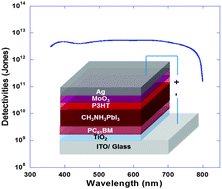Ultrasensitive solution-processed perovskite hybrid photodetectors
Abstract
In this work, we demonstrate high performance photodetectors based on organometal halide perovskite materials in a “conventional” device architecture. Due to the excellent intrinsic optical and electrical properties of perovskite materials, high photoresponsivities from 375 nm to 800 nm were obtained. By additionally modifying a sol–gel processed TiO2 compact layer with a solution-processed [6,6]-phenyl-C61-butyric acid methyl ester (PC61BM), the performance of the perovskite photodetectors is further improved through simultaneously enhancing the photocurrent via facilitating the charge carrier transport at the CH3NH3PbI3/PC61BM interfaces, and suppressing the dark current densities by passivating the inhomogeneous TiO2 film. As a result, external quantum efficiencies over 80% and detectivities greater than 4 × 1012 cm Hz1/2 W−1 are obtained from 375 nm to 800 nm. In addition, on account of the “conventional” structure of the device, as well as the low-temperature solution-processed nature of each layer, our perovskite photodetectors exhibit much superior compatibility with large-scale commercialization methods.


 Please wait while we load your content...
Please wait while we load your content...